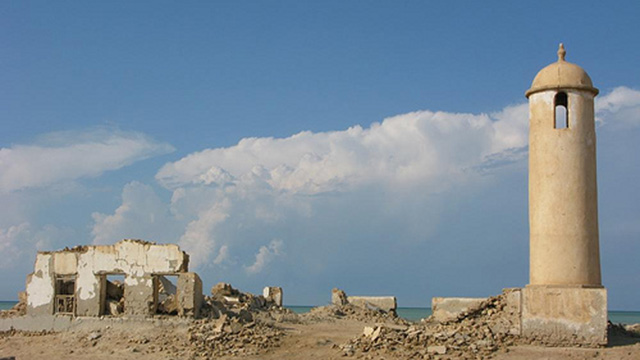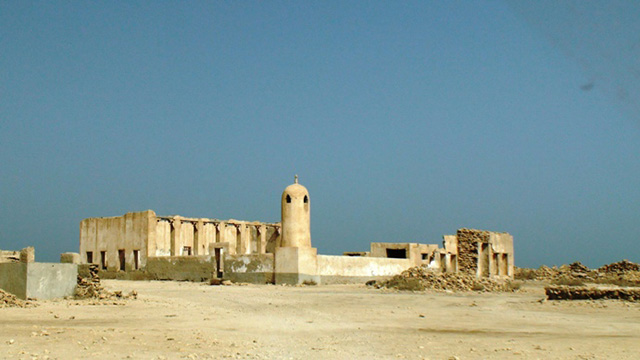Fishermen s villages
Several settlements in the northwest of Qatar give a glimpse of how difficult life outside of the main cities was before the discovery of oil.
These small villages had economies based largely on fishery, and lacked facilities or road access.
Three of the sites, Al-Areesh, Al-Khuwair and Al-Jemail, are completely abandoned today, yet still vividly tell the story of those who once called them home.
All three settlements were built at the beginning of the 19th century and their names have intriguing origins. Al-Areesh comes from the Arabic 'areesh,' meaning shelter made by date palm fronds, while Al-Kuwair comes from 'kuwair,' meaning small seawater canal.
These villages were first abandoned in 1937, but daily life resumed in 1945 and continued well into the 1970s when the residents once again picked up and left.Traditional Qatari mosques rest at the heart of the villages and are surrounded by a few old fishermen's houses.
This layout reflects how the social structure of Qatari communities was - and still is - centered around faith and religion.
The mosques have a typical plan, fenced in by high walls and open to an internal courtyard. There is a 'mothawaddah,' a separate room in the courtyard for the 'wudu,' or ablutions. In one corner is a minaret, which is a circular shaft with a simple rounded top and a small arched door that opens to a narrow spiral staircase. On the top of the minaret, a small room opens to the surroundings with four little windows that were used by the 'muezzin' to call people to pray.
The prayer area of the mosques is split into two spaces: an 'iwan,' or outer prayer room consisting of a portico overlooking the courtyard, and an indoor prayer area where the 'mehrab' is directed towards the 'Kaaba' at Mecca. Walls inside these mosques are often decorated with Quranic quotations, drawings made by fishermen and various other symbols.
Visiting these villages gives an idea of the traditional Qatari building technique.
The thick walls, which helped to isolate the heat and keep buildings cool, were built by overlapping raw pieces of coral rock and limestone, joining them with mud mortar and covering them with gypsum-based plaster. The roof is made of four layers. The first consists of a series of 'danchal' wood poles, often protected by bitumen. The second is a layer of 'basgijl,' which are woven bamboo strips. A close net of mangrove branches makes up the third layer, and the roof is then finished with a layer of compressed mud, which provided protection from the sun during the hot seasons. One of the most interesting features of this technique is the building of architraves using poles of 'danchal' wood held together with a rope. This increases the adherence of the mud mortar and plaster.
A visit to the fishermen's villages in the northwest or the 3D model of the Qatari mosque clearly shows this building technique.
Planning a visit
The northwest villages should be visited between September and April so you can spend time discovering the features of the deserted dwellings.
Before visiting the sites, take a look at the 3D model of the Qatari mosque and bring it along as a
reference.
Consider bringing some snacks and refreshments as well, as the nearest restaurant is in Madinat Al-Shamal. Please remember not to litter the area and to take any garbage back with you. The site is always open and there is no admission fee.
While it is possible to visit these villages driving a standard car, using a four-wheel drive vehicle would be more comfortable.
UTM coordinates:
Al-Areesh N 26° 03' 03.42" E 51° 03' 24.57"
Al-Jemail N 26° 05' 46.89" E 51° 09' 21.94"
Al-Khuwair N 26° 04' 07.38" E 51° 05' 02.30"
Address:
The villages are located in the northwest of Qatar, 130 km from Doha. Take the North Road to Al-Khor for approximately 50 km and make a U-turn at the Zubarah sign.
Take the first secondary road on your right. Keep going straight until you see the AlZubarah fort on the right. Just before the fort, turn right and go 10 km. The junctions to the villages of Al-Areesh and Al-Khuwair have a sign, and the town of Al-Jemail is visible from the road. You can also reach the sites through the north via Madinat AlShamal.














